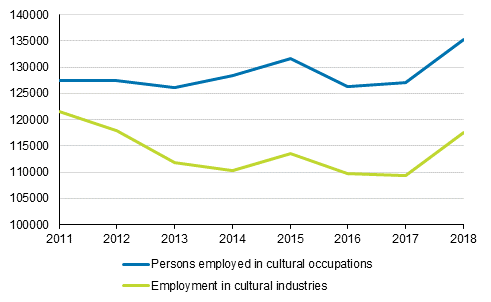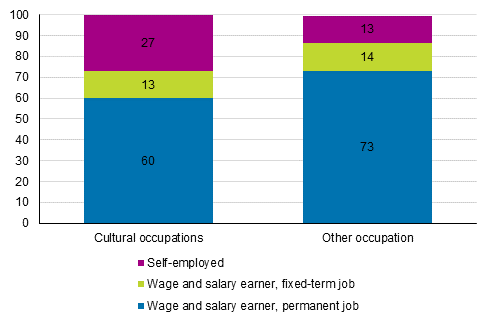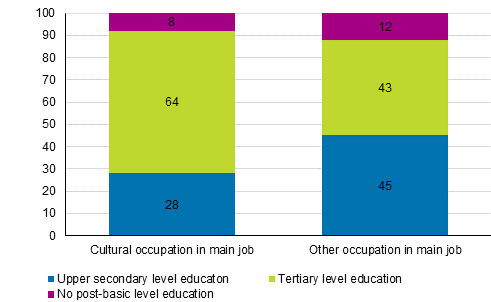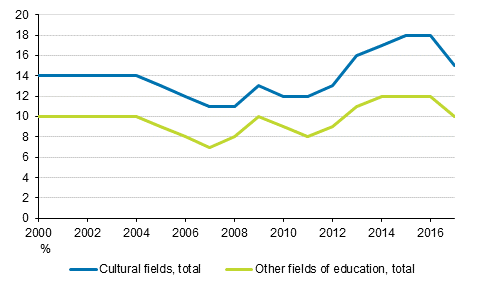Published: 10 June 2019
Number of persons working in cultural occupations and industries increased in 2018 from the year before
Correction on 10 June 2019. The correction is indicated in red,
The number of persons working in cultural occupations and industries increased. In 2018, the employment development was favourable in both the national economy and the fields of culture. According to Statistics Finland’s Labour Force Survey, employment in cultural industries was around 117,000 and around 135,000 persons worked in cultural occupations in 2018. The growth in employment in the industries was over six per cent from the previous year and the growth in employment in cultural industries around seven per cent. It should, however, be borne in mind that the Labour Force Survey is a sample survey, and there are uncertainties connected to the estimates. Estimates’ 95 per cent confidence interval +-6,700 (Figure 1).
Figure 1. Employment in cultural industries and occupations in 2011–2018

Source: Statistics Finland: Labour Force Survey
A considerably large share of those working in cultural occupations were self-employed. Seventy-three per cent were working as wage and salary earners and 27 per cent were self-employed, while the shares in other occupations were 87 and 13 per cent (Figure 2).
Only 60 per cent of those employed in cultural occupations had a permanent employment relationship, while the corresponding share for those working in other occupations was 73 per cent. The difference is explained by the large share of self-employed persons. Thirteen per cent of those employed in cultural occupations worked in fixed-term positions and the remaining 27 per cent were self-employed.
Figure 2. Permanency of employment relationship in cultural and other occupations in 2018

Source: Statistics Finland: Labour Force Survey
Part-time work was considerably more common in cultural occupations than in other occupations. Twenty-three per cent of those in cultural occupations had a part-time job, while in other occupations only 16 per cent worked part time.
Persons working in cultural occupations often perform project-type short-term jobs, and several simultaneous jobs are also common. Around 11 per cent of those in cultural occupations had more than one job and some six per cent of those working in other occupations in 2018.
The average weekly working hours of those working in cultural occupations as their main job are slightly shorter than among those in other occupations. It was 32 hours in cultural occupations and nearly 36 hours in other occupations.
In both cultural occupations and industries, the number of men and women on the total level is almost equal.
Male-dominated occupations include sales and marketing managers, broadcasting and audio-visual technicians, musical instrument makers and tuners, glass-makers, cutters, grinders and finishers, engravers, etchers, printers, print finishing and binding workers.
According to the employment statistics, female-dominated occupations include e.g. filing and copying clerks, library clerks, interior designers and decorators, dancers and choreographers, and crafts and art teachers ( Employed labour force in cultural occupations by gender ).
Among industries, e.g. printing of newspapers and other papers was dominated by men, while translation and interpretation was a female-dominated industry.
Cultural professionals are highly educated. Sixty-four per cent of those working in cultural occupations had tertiary level education, while the share was only 43 per cent in other occupations. Twenty-eight per cent of those employed in cultural occupations had upper secondary level education. Eight per cent had not acquired post-basic level education (Figure 3).
These data derive from Statistics Finland’s Labour Force Survey and employment statistics.
Figure 3. Level of education distribution of those working in cultural and other occupations as their main job in 2018, %

Labour force and unemployment rate of those with qualifications in the field of culture
The labour force with qualifications in the field of culture has more than doubled from 2000 and was 87,166 in 2017. The activity rate of those with qualifications in the field of culture among the whole labour force with qualifications has also grown from 2.1 per cent in 2000 to 3.8 per cent in 2017.
The unemployment rate of those with qualifications in the field of culture one year after graduation has long been higher than the average unemployment rate of all fields of education. However, in 2017 it decreased by three percentage points, one percentage point more than in all fields of education ( Cultural Statistics table service, Table 11.6. ).
Figure 4. Unemployment rate of those with qualifications from the cultural industry and from all fields of education one year after graduation in 2000 to 2017

Source: Statistics Finland, Education statistics
In 2018, the number of unemployed jobseekers in arts occupations was 6,217, around 13 per cent fewer than in the year before. Of all unemployed jobseekers 2.4 per cent were arts professionals. Almost 36 per cent of unemployed jobseekers in arts occupations were visual artists ( Cultural Statistics table service, Table 11.7 ).
These data derive from Statistics Finland’s education statistics and the Employment Service Statistics of the Ministry of Economic Affairs and Employment.
Earnings in cultural occupational groups
In 2017, over 29,000 workers in cultural occupations were employed in the private sector. Of these, 49 per cent were women. In the private sector, the average regular monthly earnings of cultural occupation groups were EUR 3,596, for men EUR 4,004 and for women EUR 3,297.
Advertising and public relations managers attained earnings of over EUR 6,000. The average earnings of men were EUR 6,413 and of women EUR 6,237. The earnings were lowest, EUR 2,431, among technical employees at galleries, museums and libraries ( Culture Statistics table service Table 11.9) .
A total of 412,509 persons were working in the local government sector in 2018. Around 6,000 of them worked in cultural occupations. In the local government sector, the average regular monthly earnings were EUR 3,105. In cultural occupations, it was EUR 2,942, on average. Theatre directors earned most, EUR 5,351, on average. City architects also attained earnings of over EUR 5,000. Museum assistants’ earnings remained under EUR 2,000 as they earned EUR 1,870, on average.
Source: Cultural statistics 2018 Statistics Finland
Inquiries: Kaisa Weckström 029 551 2348, kulttuuri.tilastokeskus@stat.fi
Director in charge: Jari Tarkoma
Publication in pdf-format (194.9 kB)
- Tables
-
Tables in databases
Pick the data you need into tables, view the data as graphs, or download the data for your use.
Updated 10.6.2019
Official Statistics of Finland (OSF):
Culture [e-publication].
ISSN=2341-7404. Cultural Employment in Finland 2018. Helsinki: Statistics Finland [referred: 19.12.2025].
Access method: http://stat.fi/til/klt/2018/01/klt_2018_01_2019-06-10_tie_001_en.html

